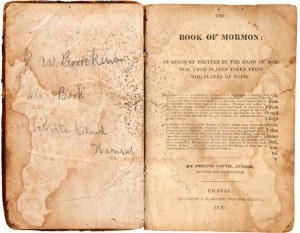The Paris Review's Blog, page 911
June 4, 2012
Thefts, Maps, and the Return of Oprah
A rare, first-edition Book of Mormon has been stolen from an Arizona store.
The Atlantic presents a slideshow of images from the “graphic canon,” in which artists take on the classics.
Will 2012 be the biggest Book Expo ever?
An interactive map of the UK’s literary destinations.
The return of Oprah’s Book Club.
June 1, 2012
Francisco Goldman, Mexico City
A series on what writers from around the world see from their windows.
My desk is snugly ensconced in a front corner of the living room, facing wall and bookshelves, a wide window overlooking a park in Colonia Roma to the right, and on my left, the narrow side-window drawn by Matteo. I’m sharing the apartment with my friend Jon Lee, who is almost always traveling but he needed a Latin American base for his work. We only moved in a month ago. It’s the biggest apartment I’ve ever lived in. The living room is so immense that I bought a football (not a futbol) just to prove you can play catch in it, and now I am looking for a wiffleball batting machine, which I think would be a great way to manage the persistent physical restlessness that often makes it so hard for me to sit still at a desk. In the mornings I go down to a café facing the park for breakfast. They have terrific coffee. I usually have the waitress tell me about the chilaquiles, the enfrijoladas, molletes and omelettes just so that I can savor her descriptions, and then I order the fruit and granola, and she makes me fun of me about that. I work in the café for two or three hours and then go back to the desk in my apartment. Apart from a break for lunch, I try to work until seven in the evening, and then usually head to the gym. We’re right around the corner from one of Mexico City’s greatest cantinas, one I’d been coming to for years from more distant neighborhoods. They have a funny ritual there. A waiter will ring a bell to catch everyone’s attention, shout out a name, and then the cavernous room will resound with raucous shouts of “¡Pendejo!” (It means, more or less, Asshole!) You have to pay the waiter to do that. Once a good friend, a writer from Ireland, was visiting, and he paid the waiter to shout out the name of another Irish writer who’d given him a nasty review, and the waiter, though he could barely pronounce the name, shouted it out, and everyone in the cantina, the old men playing dominoes, the Mexican and foreign hipsters and literary types who also hang out there, etcetera, joyously shouted “¡Pendejo!” —Francisco Goldman
Tote Contest: Now Extended!
 As readers of this space will recall, we've put out an open call: our next tote bag, a collaboration with the Strand Bookstore, will be designed by...you!
As readers of this space will recall, we've put out an open call: our next tote bag, a collaboration with the Strand Bookstore, will be designed by...you!
And due to overwhelming demand, we're extending the deadline by a week. The deadline is now: Friday, June 8.
Get in touch with your inner graphic designer/illustrator and design a tote bag that features the original Paris Review logo (as seen on our homepage and the cover of the magazine) and remember to leave room for the Strand oval, too. You can incorporate old cover art, go all graphic, or dream up something completely your own. (For further inspiration, check out our current totes!) We want to know what the Review means to you!
Submission deadline: Friday, June 8, 2012
Find both logos here
Artwork maximum size: 10 inches by 10 inches
EPS vector format preferred; 300 dpi acceptable
Send your entry to contests@theparisreview.org
The winning design will be revealed at the inaugural event at the Strand on June 13, 2012.
Top entries will be posted on the Paris Review Daily. The grand-prize winner will receive a Strand shopping spree and a year subscription to The Paris Review. Plus, of course, your tote.
What We’re Loving: Sundry Practices, New Order, Flower Power
The enthusiasms of our Southern editor (plus a fact-checking query from issue 201) have sent me back to Urne-Buriall, Sir Thomas Browne’s 1658 essay on the “sundry practises, fictions, and conceptions, discordant or obscure” surrounding funerals and the afterlife: “Why the Female Ghosts appear unto Ulysses before the Heroes and masculine spirits? Why the Psyche or soul of Tiresias is of the masculine gender; who being blinde on earth sees more than all the rest in hell; Why the Funerall Suppers consisted of Egges, Beans, Smallage, and Lettuce, since the dead are made to eat Asphodels about the Elyzian medows? Why since there is no Sacrifice acceptable, nor any propitiation for the Covenant of the grave; men set up the Deity of Morta, and fruitlessly adored Divinities without ears? It cannot escape some doubt.” —Lorin Stein
“If beauty is defined as a composite quality encompassing both extraordinary sensoriality and exemplary human behavior, then possibly the most beautiful flower shop in the world is located in Vienna’s low-key-but-hip 4th District.” So begins The Flower Shop: Charm, Grace, Beauty & Tenderness in a Commercial Context, which is a little hard to describe to those unfamiliar with the work of author Leonard Koren. It’s a profile of Vienna’s Blumenkraft, told through sepia-toned photographs and text, but it’s also more than that. You learn how a flower shop functions, from the selection of the wares to caring for flowers to arranging, and you get to know the staff and experience the challenges and triumphs of running a small business and of trying to bring something beautiful, unique, and ephemeral into the world. It ends up being a much bigger story than that of one florist, however lovely. —Sadie Stein
New Order, “Leave Me Alone.” I’m not sure how I’ve never discovered this masterpiece of new wave mellow-dee. Perhaps it’s been sitting on the toadstool of my mind, elbow on knee, hand on chin, waiting for the perfect moment to ring out. As a fan of New Order’s calmer music—“Regret,” “Love Vigilantes,” “Ceremony (Single Version)”—“Leave Me Alone” ranks high in its moody solitude. Bernard Sumner rolls the song along slow at first, but the urgency in his voice picks up as his “character” becomes more frustrated in his inability to escape the company of others. The lyrics keep in line with New Order’s usual sexual despondence:
From my head to my toes
To my teeth, through my nose
You get these words wrong
You get these words wrong
Everytime
You get these words wrong
I just smile.
—Noah Wunsch
There are so many reasons to be excited about art this year—great gallery and museum shows all around the country. Lucky Chicagoans are catching the tail end of a Claude Cahun exhibition and are a month into the Art Institute’s display of their newly acquired Dawoud Bey collection. The twenty-five black-and-white photographs are comprised by Bey’s “Harlem, U.S.A.” series, which was first shown more than thirty years ago at the Studio Museum in Harlem. If you’re not in Chicago, I recommend the handsome catalogue—the photographs are worth extended viewings, and his images of the Manhattan neighborhood’s denizens stand alongside the work of Robert Frank, Garry Winogrand, Diane Arbus, and James Van Der Zee as definitive American portraits. —Nicole Rudick
My favorite movie of the last five years is probably Reprise, by the Norwegian director Joachim Trier. I loved its sense of humor and its sense of possibility. Trier used the devices of the nouvelle vague, not with irony or nostalgia, but as if they were brand new—as if Oslo today were Paris circa 1964. Most of all I loved Anders Lie’s performance as a brilliant writer in the grip of a life-threatening depression. Oslo, August 31, which was released last week in New York, has all of these things, too, including Lie as a recovering addict who thinks he will never piece his life back together. Despite the similarities, Lie’s performance in Oslo is full of surprises. I can’t think of a movie actor my age who is more fun to watch. —L.S.
Cabins, Kafka, and KFC!
Cabin fever.
When writers paint.
Kafkaesque! Israel vs. Cat Lady over Kafka papers.
RIP Brain, Child.
Play your (Facebook) cards right and you could be the proud owner of Colonel Sanders's autobiography.
“It was our misfortune to have sadistic and fanatical guards.” Vonnegut's letter from the real Slaughterhouse Five.
May 31, 2012
The Supremes
Here’s how I fell in love with the Supreme Court: riding a Boston city bus, earbuds in, listening to the justices’ voices. As the court debated a Chicago loitering law—a law that allowed the police to arrest not only gang members but anyone with them for lingering with “no apparent purpose” in a public place—I stared out the window at the people passing on the street. It felt provocative to overlay a high-minded argument about society on top of society as it actually existed, and I wondered whether I would hear any of my world reflected back at me from the court. Then Justice David Souter spoke, forcefully. “I'm still bothered by the seemingly open-ended possibilities of determining what is or is not an apparent purpose,” he said. “Some people, for example, with nothing better to do like to sit and watch, or stand and watch, the cars go by. That’s a purpose.” I was hooked.
Here’s how you might fall in love with the Supreme Court: sitting in a dark theater, watching two actors facing one another in desk chairs on a minimally dressed stage, reenacting an oral argument. This is Arguendo, a new play from Elevator Repair Service, still being developed in workshop but presented in four early performances on May 17 and 18 at a sixty-seat black-box theater in Brooklyn. Elevator Repair Service is best known for Gatz, a theatrical endurance test in which F. Scott Fitzgerald’s The Great Gatsby is performed in its entirety over the course of six hours. Arguendo, only forty minutes long in its present incarnation, rewards a different kind of persistence. It challenges its audience to enter in the middle of a conversation—after written briefs are filed but before an opinion has been issued—ignorant of the law, of legal language, and of the justices. We are asked to ride out that ignorance with the promise that it will yield to wisdom and delight.
Don’t Miss the 1966 Tee
In celebration of its two-hundredth issue, The Paris Review is proud to present the Winter 1966 T-shirt. Modeled on a nifty shirt that we discovered on the back cover of issue 36, the design is George Plimpton’s own. As he stated in that ad, it’s “the sort of once in a very rare while shirt that makes an editor proud to do his job.”
 To celebrate the ’66, we took to the street, asking some New York friends to name their favorite Paris Review authors. Watch this space to see their picks.
To celebrate the ’66, we took to the street, asking some New York friends to name their favorite Paris Review authors. Watch this space to see their picks.
Printed on American Apparel 50/25/25’s, the shirt comes in men’s (S, M, L) and women’s sizes (M, L).
To quote George, we beg you to “share with us the thrill of wearing it.”
Offer good for U.S. addresses only.
Dear Joan Holloway, Was It Something I Said?
Just wanted to check in, as I can’t help but feel slightly responsible for your actions in this week’s episode. I thought these letters from the future would do you all some good, providing twenty/twenty hindsight into your blindingly Day-Glo historical moment. But Doc Brown was right: messing with the past can alter the future in unexpected ways. Matthew Weiner and company thrive on this very notion; they’ve remodeled the mid-sixties into an era in which cigarettes don’t cause cancer, and the advertising industry is the pinnacle of glamour, filled with beautiful people in beautiful clothes making eyes at each other across rooms then retreating into bedrooms with beautiful bed frames for bouts of steamy congress in which panties always match the bra, and a woman can achieve orgasm just by inhaling Don’s smoky musk.
No surprise, then, that here in 2012 we’ve gone gaga over sixties style, sporting skinny ties and summer plaids, puffing cigs like we’re unaware of science, and ruining perfectly healthy marriages because, according to Pete Campbell’s friend from the commuter train, variety is the spice of life. We should probably all reread Richard Yates. Maybe it was wrong to tease you with a glimpse into third-wave feminism when the second wave is only now breaking against your shoreline.
But don’t think I’m judging you.Read More »
Literary Bars, Brooklyn Lamentations
RIP illustrator Leo Dillon.
Just in time for Book Expo, ten literary bars in Manhattan.
Book lovers rally around the marked-for-death University of Missouri Press.
50 Shades of Grey alternatives for the erotica addict.
The evolution of the book cover.
A Brooklyn elegy.
May 30, 2012
Queen of the Web
 Queen Elizabeth has put Queen Victoria’s complete journals online. (Well, in collaboration with Oxford’s Bodleian Libraries and ProQuest.) The 141 journals, sourced from the Royal Archives, chronicle Victoria’s life from the age of thirteen to eighty-one. The monarch was a faithful and articulate correspondent, and while the content is hardly what one might term juicy, there are certainly plenty of personal revelations, domestic details, and opportunities for analysis. (If you can read her handwriting, that is—not every journal is transcribed.)
Queen Elizabeth has put Queen Victoria’s complete journals online. (Well, in collaboration with Oxford’s Bodleian Libraries and ProQuest.) The 141 journals, sourced from the Royal Archives, chronicle Victoria’s life from the age of thirteen to eighty-one. The monarch was a faithful and articulate correspondent, and while the content is hardly what one might term juicy, there are certainly plenty of personal revelations, domestic details, and opportunities for analysis. (If you can read her handwriting, that is—not every journal is transcribed.)
On this day in 1837, the soon-to-be queen recorded,
Wrote a letter to dear Uncle Leopold. Walked. Wrote my journal. Dressed (as though I was going to an evening party.) ... Saw Dr. Clark. Played on the piano. Wrote. At 7 to 4 we dined.
The Paris Review's Blog
- The Paris Review's profile
- 305 followers







 Read More »
Read More »



